Mind the gap: Science and engineering education at the secondary–tertiary interface
DOI:
https://doi.org/10.1590/sajs.2013/20120113Keywords:
student success and throughput, academic development, curriculum responsiveness, educational innovation, school–university interfaceAbstract
In the South African higher education sector, there is increasing concern about the poor retention and throughput rates of undergraduate students. There is also concern that the participation rates in higher education, relative to population demographics, remain extremely racially skewed. With the quality of schooling unlikely to change dramatically in the short term, universities need to look for ways to improve student success, particularly in science and engineering, where graduates are needed for a range of key roles in society. Here we review the research presented at a forum held by the Academy of Science of South Africa in 2010, which sought to bring together the latest expert thinking in this area. The major focus of academic development to date has been the establishment of extended degree programmes. However, it is clear that this model has limited capacity to deal with what is, in fact, a much broader problem. We summarise existing interventions aimed at reducing the ‘gap’ between secondary and tertiary education, and describe key innovations in mainstream programmes that are possible at the levels of pedagogy, curriculum and institutional environment, some of which are also becoming established internationally in science and engineering. Driving such initiatives will demand visionary university leadership in order to effect the integrated and holistic change that is needed.
Published
Issue
Section
License

All articles are published under a Creative Commons Attribution 4.0 International Licence
Copyright is retained by the authors. Readers are welcome to reproduce, share and adapt the content without permission provided the source is attributed.
Disclaimer: The publisher and editors accept no responsibility for statements made by the authors
How to Cite
- Abstract 508
- PDF 433
- EPUB 177
- XML 190













.png)